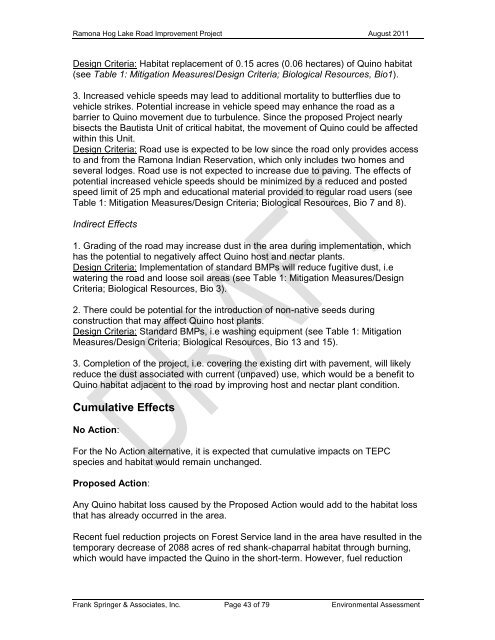environmental assessment for the hog lake road improvement project
environmental assessment for the hog lake road improvement project
environmental assessment for the hog lake road improvement project
You also want an ePaper? Increase the reach of your titles
YUMPU automatically turns print PDFs into web optimized ePapers that Google loves.
Ramona Hog Lake Road Improvement Project August 2011<br />
Design Criteria: Habitat replacement of 0.15 acres (0.06 hectares) of Quino habitat<br />
(see Table 1: Mitigation Measures/Design Criteria; Biological Resources, Bio1).<br />
3. Increased vehicle speeds may lead to additional mortality to butterflies due to<br />
vehicle strikes. Potential increase in vehicle speed may enhance <strong>the</strong> <strong>road</strong> as a<br />
barrier to Quino movement due to turbulence. Since <strong>the</strong> proposed Project nearly<br />
bisects <strong>the</strong> Bautista Unit of critical habitat, <strong>the</strong> movement of Quino could be affected<br />
within this Unit.<br />
Design Criteria: Road use is expected to be low since <strong>the</strong> <strong>road</strong> only provides access<br />
to and from <strong>the</strong> Ramona Indian Reservation, which only includes two homes and<br />
several lodges. Road use is not expected to increase due to paving. The effects of<br />
potential increased vehicle speeds should be minimized by a reduced and posted<br />
speed limit of 25 mph and educational material provided to regular <strong>road</strong> users (see<br />
Table 1: Mitigation Measures/Design Criteria; Biological Resources, Bio 7 and 8).<br />
Indirect Effects<br />
1. Grading of <strong>the</strong> <strong>road</strong> may increase dust in <strong>the</strong> area during implementation, which<br />
has <strong>the</strong> potential to negatively affect Quino host and nectar plants.<br />
Design Criteria: Implementation of standard BMPs will reduce fugitive dust, i.e<br />
watering <strong>the</strong> <strong>road</strong> and loose soil areas (see Table 1: Mitigation Measures/Design<br />
Criteria; Biological Resources, Bio 3).<br />
2. There could be potential <strong>for</strong> <strong>the</strong> introduction of non-native seeds during<br />
construction that may affect Quino host plants.<br />
Design Criteria: Standard BMPs, i.e washing equipment (see Table 1: Mitigation<br />
Measures/Design Criteria; Biological Resources, Bio 13 and 15).<br />
3. Completion of <strong>the</strong> <strong>project</strong>, i.e. covering <strong>the</strong> existing dirt with pavement, will likely<br />
reduce <strong>the</strong> dust associated with current (unpaved) use, which would be a benefit to<br />
Quino habitat adjacent to <strong>the</strong> <strong>road</strong> by improving host and nectar plant condition.<br />
Cumulative Effects<br />
No Action:<br />
For <strong>the</strong> No Action alternative, it is expected that cumulative impacts on TEPC<br />
species and habitat would remain unchanged.<br />
Proposed Action:<br />
Any Quino habitat loss caused by <strong>the</strong> Proposed Action would add to <strong>the</strong> habitat loss<br />
that has already occurred in <strong>the</strong> area.<br />
Recent fuel reduction <strong>project</strong>s on Forest Service land in <strong>the</strong> area have resulted in <strong>the</strong><br />
temporary decrease of 2088 acres of red shank-chaparral habitat through burning,<br />
which would have impacted <strong>the</strong> Quino in <strong>the</strong> short-term. However, fuel reduction<br />
Frank Springer & Associates, Inc. Page 43 of 79 Environmental Assessment
















